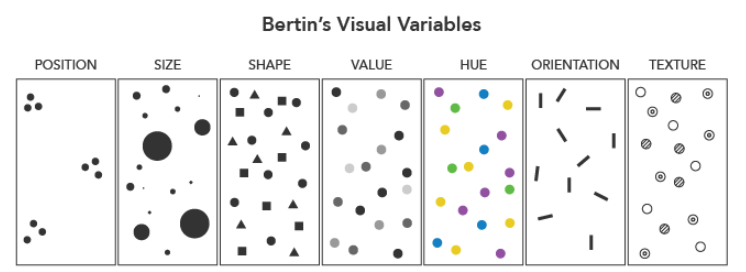Symbol Design: Visual Order and Categories
Symbol Design: Visual Order and Categories
When designing your maps, two ideas should be at the forefront of your symbol design process: (1) order, and (2) category. Map symbol design relies heavily on the proper use of visual variables—graphic marks that are used to symbolize data (White, 2017).
Cartographer Jacques Bertin (1967) was the first to present this system of encoding data via graphic elements. Suggestions of supplemental visual variables (e.g., transparency), as well as analyses of their utility in different cartographic contexts, have been brought forth by multiple well-known cartographers (e.g., MacEachren 1994).

Image description: A chart illustrating Bertin’s Visual Variables, displaying seven categories: Position, Size, Shape, Value, Hue, Orientation, and Texture. Each category is shown as a vertical column with a series of symbols exemplifying the visual variable.
- Position: Two groups of small black circles arranged diagonally within a white rectangular column.
- Size: Black circles of varying sizes scattered randomly within a white column.
- Shape: A mix of small black triangles, circles, and squares spread across a white column.
- Value: Black and gray circles with different shades of gray arranged within a white column, indicating varying values.
- Hue: Circles in different colors (purple, green, blue, yellow) scattered in a white column.
- Orientation: Black lines at various angles within a white column.
- Texture: Circles with different interior textures (solid black, white with dots, white with horizontal lines) arranged within a white column.
Some visual variables (e.g., size, color saturation, and color lightness) clearly indicate quantitative changes in magnitude. These are best for encoding data that has an order (e.g., a county-level map of population density; a road map with both highways and local roads). Other visual variables (e.g., color hue, pattern, and shape) signify qualitative—but not quantitative—differences. These are best applied when data categories have no inherent ordering (also often called nominal, or qualitative data), such as in a choropleth map showing political boundaries.
Figures 1.7.2, 1.7.3, and 1.7.4 demonstrate how visual variables can be used to symbolize common features in general purpose maps. These variables can be used either independently or in combination, to create the best visual representation of the underlying data.

Image description: Two separate road classification legends placed side by side. Each legend consists of four distinct horizontal bars, each labeled with different types of roads and are of decreasing thickness as you go down the legend.
- Left Legend:
- The top bar is black with two white horizontal stripes and is labeled “Controlled Access Highway.”
- The second bar is completely white and is labeled “Secondary Highway.”
- The third bar is light gray and is labeled “Collector Road.”
- The bottom bar is a thin gray line labeled “Local Road.”
- Right Legend:
- The top bar is completely black and labeled “Controlled Access Highway.”
- The second bar is dark gray and labeled “Secondary Highway.”
- The third bar is medium gray and labeled “Collector Road.”
- The bottom bar is light gray and labeled “Local Road.”

Image description:Two small, side-by-side legend boxes, each containing a key for identifying “Lake or Pond” and “Reservoir.”
- Left Legend Box:
- A light gray solid square represents “Lake or Pond.”
- A light gray square with diagonal black stripes represents “Reservoir.”
- Right Legend Box:
- A blue solid square represents “Lake or Pond.”
- A light green square with diagonal darker green stripes represents “Reservoir.”
Each legend box has a thin black border with a white background. The text is in black, and all elements are clearly distinguishable.

Image description: A simple map legend contained within a rectangular white box outlined in black. The legend has two entries indicating different types of paths. The first entry consists of a solid grey line to the left, labeled “Local Road” on the right with black text. The second entry shows a dashed grey line, labeled “Trail” on the right side with black text.
Edward Tufte, a statistician and data visualization expert, said “the commonality between science and art is in trying to see profoundly—to develop strategies of seeing and showing” (Zachry and Thralls 2004, pg. 450). The goal of cartography, both an art and a science, is to optimally visualize—and help others see—the world, and various phenomena within it. To do so takes patience, practice, and skill—all of which you will continually develop throughout this course.
Student Reflection
Do a simple web search for maps of a topic that interests you. What visual variables are used in these maps? Are they effective?

